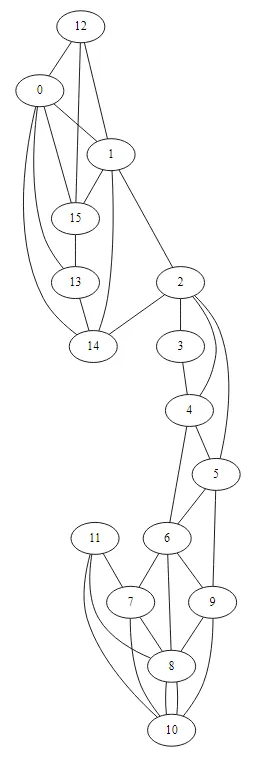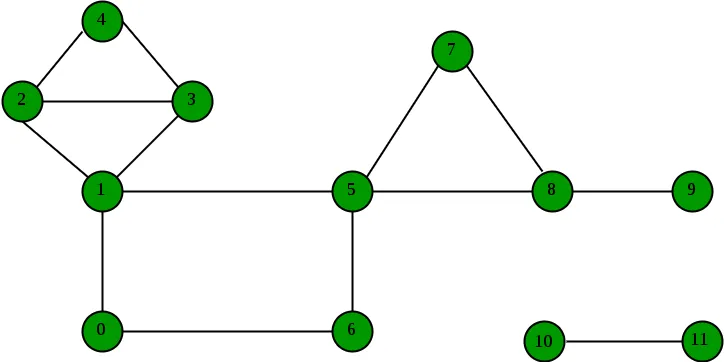寻找割点组
16
- user1312837
4
1切点组是否还有其他条件?
因为这样的组可能会非常多。例如(1, 14), (0, 1, 15), (6, 9), (11, 7, 8, 9),……我认为它们甚至可以呈指数级增长。 - Jakube
我认为这取决于这些群组的大小。切点应该将大型节点集群分开。 - user1312837
你需要更具体一些。什么是“大”?为什么4-5是可以接受的,而6-9不行? - FrankS101
根据您提供的信息,我认为没有比检查所有可能的组更好的解决方案。首先要做的是严格定义“组”的含义。在定义中留下变量是可以的,但允许的限制越多(例如,它们必须是给定最大大小的子树的节点),就增加了高效算法的可能性。否则,我确信您可以在选择中编码一个SAT问题,这将使问题成为NP难问题,这意味着没有运行时间指数与最大组大小。我会把证明留给您。 - Gene
2个回答
1
我认为除了遍历所有组合以外,没有其他更快的方法,因为您没有任何限制。(我甚至不认为这个测试有意义。)
尽管编程语言未指定,请允许我以Python为例。
当您正在进行关节点搜索时,最著名的方法是Tarjan算法。我认为每个阅读此文的人都知道它,所以如果您不介意,我将跳过它作为一个函数,您可以在https://www.geeksforgeeks.org/articulation-points-or-cut-vertices-in-a-graph/中找到它。
我写这篇文章是为了仅需要将图形分成最小长度的组。比如说(4,5),如果它已经是AP,任何点连接到它们也应该是AP。
以防万一,如果有人想要完整的测试代码。https://gist.github.com/MichaelKHTai/c438fd0911d0584be1e37f1fd1599b7e 此外,应通过跳过重复的节点组进行优化,例如(4,5)和(5,4)。
尽管编程语言未指定,请允许我以Python为例。
当您正在进行关节点搜索时,最著名的方法是Tarjan算法。我认为每个阅读此文的人都知道它,所以如果您不介意,我将跳过它作为一个函数,您可以在https://www.geeksforgeeks.org/articulation-points-or-cut-vertices-in-a-graph/中找到它。
class Graph:
#From www.geeksforgeeks.org
def worker(g, prefix, arr, u):
container = g.graph[u]
if u in g.AP():
print prefix
arr.append([prefix])
del g
else:
for i in container:
if str(i) not in prefix.split(' '):
new_prefix = prefix + ' ' + str(i)
new_g = copy.deepcopy(g)
new_g.combineNode(u, i)
if len(new_g.graph) > 1:
worker(new_g, new_prefix, arr, i)
struct = {
0:[1,12,13,14,15],
1:[2,12,14,15],
2:[3,4,5,14],
3:[4],
4:[5,6],
5:[6,9],
6:[7,8,9],
7:[8,10,11],
8:[9,10,11],
9:[10],
10:[11],
12:[15],
13:[14,15]
}
g1 = Graph (total)
for key,value in struct.iteritems():
for child in value:
g1.addEdge(key, child)
result = []
for i in range(0, total):
print 'Remove root ' + str(i)
worker(g1, str(i), result, i)
print result
我写这篇文章是为了仅需要将图形分成最小长度的组。比如说(4,5),如果它已经是AP,任何点连接到它们也应该是AP。
以防万一,如果有人想要完整的测试代码。https://gist.github.com/MichaelKHTai/c438fd0911d0584be1e37f1fd1599b7e 此外,应通过跳过重复的节点组进行优化,例如(4,5)和(5,4)。
- MT-FreeHK
1
一种方法是找到你的图形的“2-连通分量”。
2-连通图是指连接的图形,且不包含任何关节点。
任何简单图的边都可以分成一些2-连通子图。
第一个例子:
在上图中,以下是2-连通分量:- 4–2 3–4 3–1 2–3 1–2
- 8–9
- 8–5 7–8 5–7
- 6–0 5–6 1–5 0–1
- 10–11
我认为每个分量都是您问题的答案。您可以使用Tarjan算法来查找这些分量。其时间复杂度为O(|V| + |E|)或O(n + m)。
time = 0
function DFS(vertex, adj[][], low[], disc[], parent[], visited[], V, stack)
disc[vertex]=low[vertex]=time+1
time = time + 1
visited[vertex]=true
child = 0
for i = 0 to V
if adj[vertex][i] == true
if visited[i] == false
child = child + 1
push edge(u,v) to stack
parent[i] = vertex
DFS(i, adj, low, disc, visited, V, time, stack)
low[vertex] = minimum(low[vertex], low[i])
if parent[vertex] == nil AND child > 1
while last element of stack != (u,v)
print last element of stack
pop from stack
print last element of stack
pop from stack
if parent[vertex] != nil AND low[i] >= disc[vertex]
while last element of stack != (u,v)
print last element of stack
pop from stack
print last element of stack
pop from stack
else if parent[vertex] != i AND disc[i] < low[vertex]
low[vertex] = disc[i]
push edge(u,v) to stack
fuction biconnected_components(adj[][], V)
for i = 0 to V
if visited[i] == false
DFS(i, adj, low, disc, parent, visited, V, time, stack)
while stack is not empty
print last element of stack
pop from stack
来源:
https://www.geeksforgeeks.org/biconnected-components/
https://en.wikipedia.org/wiki/Biconnected_component
https://www.hackerearth.com/practice/algorithms/graphs/biconnected-components/tutorial/
- Erfan Alimohammadi
网页内容由stack overflow 提供, 点击上面的可以查看英文原文,
原文链接
原文链接



